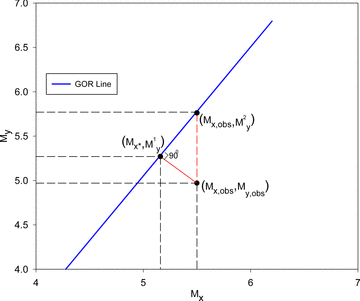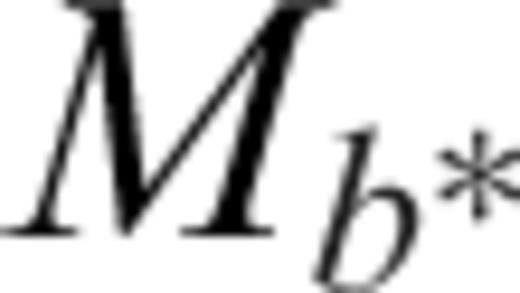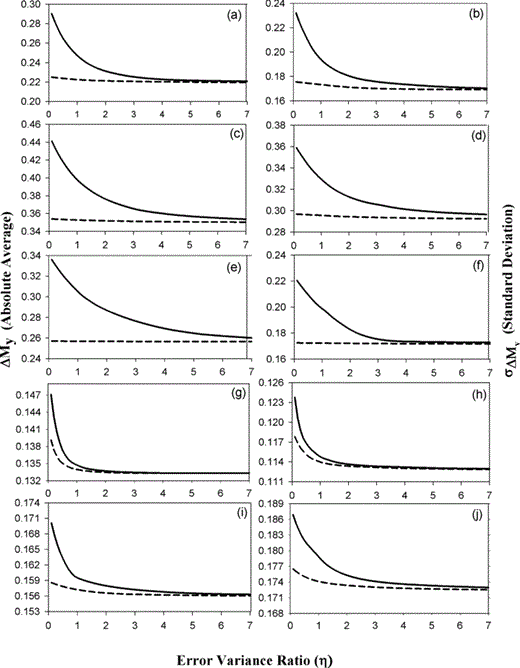-
PDF
- Split View
-
Views
-
Cite
Cite
H. R. Wason, Ranjit Das, M. L. Sharma, Magnitude conversion problem using general orthogonal regression, Geophysical Journal International, Volume 190, Issue 2, August 2012, Pages 1091–1096, https://doi.org/10.1111/j.1365-246X.2012.05520.x
Close - Share Icon Share
Summary
In this study, a procedure for the application of general orthogonal regression (GOR) towards conversion of different magnitude types is described. Through minimization of the squares of orthogonal residuals, GOR relation is obtained in terms of the abscissas (Mx*) of the projected points corresponding to the observed data pairs (Mx, obs, My, obs). In many studies, Mx* is replaced by Mx, obs in the GOR relation for convenience of obtaining the estimates of a preferred magnitude type for given magnitude values. Such forms of GOR, however, lead to biased estimates of the dependent variable. To represent the GOR relation correctly in terms of Mx, obs, a linear relation has been obtained between Mx* and Mx, obs using given points and the corresponding projected points on the GOR line.
Based on events data for the whole globe during the period 1976–2007, GOR relations have been derived for conversion of mb to Mw,mb to Ms,mb to Me and Ms to Mw following the proposed procedure and using specific error variance ratio (η) values. The superiority of the GOR relations obtained following the proposed procedure over the commonly used forms has been shown by computing the absolute average difference and standard deviation between the observed and the estimated values using events data not used in the derivation. It is observed that the proposed GOR relations yield better estimates compared to the commonly used GOR forms.
This procedure has been further tested for a wide range of η values between 0.1 and 7.0. The procedure proposed in this study can be used for the purpose of catalogue homogenization where GOR relations are applicable for conversion of different magnitude types.
1 Introduction
Several magnitude scales have been developed towards estimation of the size of earthquakes occurring in different environs, ever since the first magnitude scale was introduced by Richter (1935) based on earthquake occurrences in southern California. For seismological applications dealing with earthquake catalogues including seismic hazard assessment for a seismic region, it is generally required to express the different magnitude types into a preferred magnitude type. Usually, the most preferred magnitude is moment magnitude Mw, as it is derived directly from the seismic moment (M0) which is a fundamental physical property of the source, and Mw does not saturate for large magnitude earthquakes unlike other magnitude scales. Furthermore, energy magnitude Me is also well developed (Choy & Boatwright 1995) and is scalable with seismic energy like Mw.
Standard linear regression (SR) is the simplest and most commonly used regression procedure for magnitude conversion assuming the independent variable is either error-free or the order of its error is very small compared to the measurement error of the dependent variable. However, the use of SR is not appropriate when considering the measurement errors inherent in the magnitude estimates reported by different data sources. As an alternative, it is better to use general orthogonal regression (GOR) relation, which takes into account the errors on both the magnitude types (Gusev 1991; Castellaro et al. 2006; Thingbaijam et al. 2008; Ristau 2009). Although a SR relation is derived by minimizing the squares of the vertical residuals, GOR is obtained through minimization of the squares of the perpendicular offsets to the best-fitting line.
Development of GOR relations between different magnitude types are reported in several studies (Ristau 2009; Thingbaijam et al. 2009; Das et al. 2011). However, since the derivation of GOR relation involves the orthogonal projection of observed magnitude data pairs on the GOR line, the computation of estimates of a preferred magnitude type using these GOR relations in their existing form is liable to introduce some error. As orthogonal residuals are used in the development of GOR relations, the computation of magnitude conversion of estimates also requires to take into account the orthogonality criteria.
A proper procedure to obtain magnitude estimates using GOR relation is outlined in this study which yields better estimates compared to the commonly used form of GOR. Towards this GOR relations have been derived between mb (body wave magnitude) and Mw, mb and Ms (surface wave magnitude) and mb and Me based on global data for the period 1976–2007 and using error variance ratio (η) values for different magnitude types as obtained by Das et al. (2011). Furthermore, GOR relations between Ms and Mw derived by Das et al. (2011) assuming η= 1 have also been modified in this paper according to the proposed procedure using a computed value of η= 0.56. The advantage of the proposed GOR procedure is demonstrated by comparing the computed estimates with the corresponding observed values for a set of mb and Ms magnitudes, not calculated using the proposed GOR relations.
2 Gor Proceedure
GOR is designed to account for the effects of measurement errors in both magnitude types. The principle of GOR involves the minimization of perpendicular residuals between the given points and the corresponding points on the GOR line given by their orthogonal projections. The basic procedure for GOR is described in detail in the literature (Madansky 1959; Fuller 1987; Kendall & Stuart 1979; Carroll & Ruppert 1996; Das et al. 2011) and thus is not described here.

 is the abscissa of the point on the GOR line which is the orthogonal projection of the given point (Mx, obs, My, obs) and c1 and c2 represent the slope and the intercept of the line, respectively (Fig. 1).
is the abscissa of the point on the GOR line which is the orthogonal projection of the given point (Mx, obs, My, obs) and c1 and c2 represent the slope and the intercept of the line, respectively (Fig. 1).
General orthogonal regression relation between Mx and My showing the given point (Mx, obs, My, obs) and the corresponding point ( , M1y) on the GOR line. The estimate M2y yielded by eq. (2) for the given point is also shown.
, M1y) on the GOR line. The estimate M2y yielded by eq. (2) for the given point is also shown.

The estimate M2y given by eq. (2) is different from the actual estimate M1y given by the GOR relation (eq. 1), as the abscissa of the projected point on the GOR line,  , is different from the abscissa of the given point, that is, Mx, obs (Fig. 1). Hence, the commonly used form of GOR relation (eq. 2) with c1 and c2 of eq. (1) yields biased estimates for My, that is the converted magnitude values. The abscissas of the observed and projected points are the same only in case of standard linear regression line which is obtained by minimizing vertical residuals.
, is different from the abscissa of the given point, that is, Mx, obs (Fig. 1). Hence, the commonly used form of GOR relation (eq. 2) with c1 and c2 of eq. (1) yields biased estimates for My, that is the converted magnitude values. The abscissas of the observed and projected points are the same only in case of standard linear regression line which is obtained by minimizing vertical residuals.
 values, determined by the orthogonal projection of the given points (Mx, obs, My, obs) on the GOR line as given below.
values, determined by the orthogonal projection of the given points (Mx, obs, My, obs) on the GOR line as given below. 

3 Data Set
Body and surface wave magnitudes of earthquakes for the entire globe from the International Seismological Centre (ISC, UK ), database and moment magnitudes from Global Centroid Moment Tensor (GCMT) database () during the period 1976–2007 have been compiled in this study. Body wave magnitudes for 71 339 events, surface wave magnitudes for 70 339 events and moment magnitudes for 27 229 events have been used in all. Some events are seen to be common within different data sets used for deriving relations for conversion of different magnitude types, and similarly within different testing data sets.
4 Conversion of Different Magnitude Types Using Gor Procedure
4.1 Body wave magnitude conversion
For the development and validation of a GOR relationship between mb and Mw, a data set for 20 466 events with mb, obs and Mw, obs magnitude values has been considered from ISC and GCMT databases for the entire globe for the period 1976–2007 in the magnitude range 4.4 ≤mb≤ 6.2. This data set has been further subdivided into two subsets with 19 466 randomly selected events included in the first subset and the remaining 1000 events in the second subset. Although the first subset has been used to develop GOR relation, the second subset has been used to test and validate the proposed GOR.

 values is given by
values is given by 


Plots of regression relations using commonly used form of GOR (solid line) and proposed form of GOR (dashed line): (a) between mb,obs and Mw, (b) between mb,obs and Ms, (c) between mb,obs and Me, (e) between Ms,obs and Mw in the range 3.1 ≤Ms≤ 6.1, (f) between Ms,obs and Mw in the range 6.2 ≤Ms≤ 8.4. A combined plot of Ms and Mw data pairs showing the bilinear trend is also given in (d).



This GOR relation and its commonly used form,that is eq. (8) with mb* replaced by mb,obs, are shown in Fig. 2(b).


This GOR relation and its commonly used form given by eq. (11) with mb* replaced by mb,obs are shown in Fig. 2(c).
The data shown in the Figs 2(a)–(f) contain measurement errors and the GOR best-fitting lines are drawn based on specific values of error variance ratio (η) between the magnitude types involved. It can be seen that the lines representing the GOR equations developed using proposed methodology are closer to the trend of the data compared to commonly used GOR forms.
An attempt has been made to validate the results of the proposed GOR procedure, using test samples of 1000 (in case of mb to Mw and mb to Ms relations) and 100 (in case of mb to Me relation) observed events data not used in deriving the GOR relations. Based on a comparison between the absolute average difference and the standard deviation for the corresponding estimates provided by the two GOR forms, it is observed that estimates of the converted magnitudes obtained using the proposed procedure are found to be in better agreement with the corresponding observed values than commonly used GOR methods as shown in Figs 3(a)–(f).

A Comparison of absolute average difference and standard deviation values for the estimates given by the proposed form shown as (dashed lines) and the commonly used form shown as (solid lines) of GOR relations for different η values for various magnitude conversions, (a and b) between mb and Mw, (c and d) between mb and Ms, (e and f) between mb and Me, (g and h) between Ms and Mw in the range 3.1 ≤Ms≤ 6.1, (i and j) between Ms and Mw in the range 6.2 ≤Ms≤ 8.4.
4.2 Surface wave magnitude conversion
It is observed that the 17 009 global Ms events for magnitude range 3.1 ≤Ms≤ 8.4, considered in this study depict a bilinear trend (Fig. 2d) as was also suggested by Scordilis (2006). Therefore, the magnitude range has been divided into two parts, that is 3.1 ≤Ms≤ 6.1 and 6.2 ≤Ms≤ 8.4, on the consideration that the distribution is linear in these respective magnitude ranges.






For testing these GOR relations for the magnitude ranges 3.1 ≤Ms≤ 6.1 and 6.2 ≤Ms≤ 8.4, we used 1000 and 300 randomly selected events, respectively. It can be seen in Figs 3(g)–(j), that the GOR relations derived in this study using the proposed procedure yield improved Mw estimates compared to the estimates given by their commonly used forms.
5 Validation of Gor Procedure for η Values
The proposed GOR procedure has been further verified for a range of η values from 0.1 to 7.0 based on the comparison of the absolute average difference and the standard deviation for the corresponding estimates provided by the two GOR forms.
In the case of mb to Mw conversion relation, it is observed that the absolute average difference between the observed and the estimated values of Mw and its standard deviation are significantly lower for the proposed GOR procedure compared to the commonly used form for η values between 0.1 and 2.0 (Figs 3a and b). Similarly, for conversion of mb to Ms and mb to Me, it is found that for η values between 0.1 and 4.0, the proposed GOR procedure yields significantly lower values of the absolute average difference and its standard deviation between observed and estimated values (Figs 3c–f).
For Ms to Mw conversion, the estimates provided by the two GOR forms are found to be almost similar. However, the absolute average difference and standard deviation values are always smaller in case of the proposed GOR procedure (Figs 3g–j).
6 Summary and Conclusions
In this study, we demonstrate a GOR procedure for the conversion of different magnitude types based on events for the whole globe during the period 1976–2007. In this regard, GOR relations have been first derived in terms of the abscissa ( ) of the projected points on the line corresponding to the given data pairs (Mx, obs, My, obs). The GOR relations in this form have been derived for conversion of mb to Mw,mb to Ms and mb to Me using ISC data for 19 466, 70 339 and 739 events, respectively. Similarly, the GOR relationships for Ms to Mw conversion have been derived for magnitude ranges 3.1 ≤Ms≤ 6.1 and 6.2 ≤Ms≤ 8.4 using 15 709 Ms events from ISC. These GOR relations have been derived using specific η values as given by Das et al. (2011).
) of the projected points on the line corresponding to the given data pairs (Mx, obs, My, obs). The GOR relations in this form have been derived for conversion of mb to Mw,mb to Ms and mb to Me using ISC data for 19 466, 70 339 and 739 events, respectively. Similarly, the GOR relationships for Ms to Mw conversion have been derived for magnitude ranges 3.1 ≤Ms≤ 6.1 and 6.2 ≤Ms≤ 8.4 using 15 709 Ms events from ISC. These GOR relations have been derived using specific η values as given by Das et al. (2011).
For convenience of estimation of a preferred magnitude type (My), the GOR relations are then expressed in a form allowing direct substitution of the observed value of the magnitude (Mx, obs) as is shown in eq. (4). It is pertinent to note that direct substitution of Mx, obs, in place of Mx* in the GOR relation given by eq. (1), which is the commonly used form of GOR, shall yield biased estimates since the GOR procedure is based on the minimization of perpendicular residuals instead of vertical residuals. Hence, the use of proper form of GOR relations becomes necessary to obtain accurate estimates.
The validity of the proposed form of GOR relations have been tested based on independent events data not used in developing regression relations for a range of η values from 0.1 to 7.0, by comparing the absolute average difference and the standard deviation for the corresponding estimates provided by the two GOR forms.
In the case of mb to Mw conversion, the proposed GOR form with η= 0.2, gives the absolute average difference and standard deviation between observed and estimated Mw values as 0.224 and 0.175, respectively, whereas these values obtained by commonly used GOR form are 0.283 and 0.226. The proposed GOR form gives relatively lower values of absolute average difference and standard deviation for a range of η values between 0.1 and 2.0 (Figs 3a and b). For mb to Ms conversion with η= 0.36, the absolute average difference and standard deviation values of 0.353 and 0.296, respectively, are obtained for the proposed GOR form compared to the corresponding values of 0.423 and 0.347 for the commonly used GOR form. These values are evaluated based on 1000 test events data. It is observed that for mb to Ms conversion, proposed GOR gives lower values of absolute average difference and standard deviation for η values between 0.1 and 4.0 (Figs 3c and d).
Similarly, for mb to Me and Ms to Mw conversions, the proposed GOR form yields lower values of absolute average and standard deviation for the differences between observed and estimated values compared to the commonly used form (Figs 3e and f and g–j).
The GOR procedure demonstrated in this study thus provides an effective way of obtaining improved magnitude conversions that can be applied to obtain homogenized earthquake catalogues for a seismic region. The order of improvement in the estimates, however, depends on the magnitude type and the η value used.
Acknowledgments
The authors are grateful to the reviewers, for their critical reviews and constructive suggestions, which helped improve technical content significantly. The second author is thankful to AICTE, Govt. of India for award of National Doctoral Fellowship.
References





